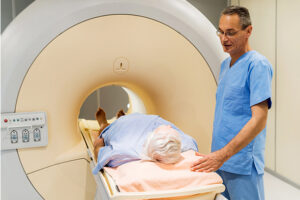Oncology
Prostate Cancer
Advanced Prostate Cancer Imaging: Advantages and Pitfalls of PSMA PET/CT
Overview
Prostate-specific membrane antigen (PSMA) positron emission tomography (PET)/computed tomography (CT) is more sensitive than conventional imaging in detecting recurrence and staging high-risk patients. However, the implications of the earlier detection of metastatic disease on patient outcomes are still unknown.
When is PSMA PET/CT best used, and what are the advantages and pitfalls of this modality?
Michael J. Morris, MD
|
|
“High-risk patients and patients who are undergoing surgery or radiation are among those who are likely to benefit from 68Ga-PSMA-11. Generally, this population includes patients with high-volume, high-grade, and/or high levels of PSA without evidence of metastasis on conventional imaging.”
We have been participating in clinical trials using 68Ga-PSMA-11, and we found that 68Ga-PSMA-11 PET/CT or magnetic resonance imaging (MRI) is superior to standard/conventional imaging with bone CT scan or MRI to diagnose regional or metastatic disease. 68Ga-PSMA-11 is also superior to 18F-fluciclovine PET/CT for hormone-sensitive prostate cancer. High-risk patients and patients who are undergoing surgery or radiation are among those who are likely to benefit from 68Ga-PSMA-11. Generally, this population includes patients with high-volume, high-grade, and/or high levels of prostate-specific antigen (PSA) without evidence of metastasis on conventional imaging.
We will also use PSMA PET/CT imaging for patients who received previous radiation therapy or surgery and failed biochemically. In this group, the ideal candidate would be a patient post prostatectomy with negative margins but with rising PSA levels with a relatively low likelihood of a response to radiation alone. PSMA PET/CT or MRI can also identify lymph node metastases that are outside the fields of standard lymphangiectomy or radiation therapy. In approximately 30% to 40% of cases, we may modify our treatment plans based on these findings. For example, if we see evidence of lymph node involvement on PSMA PET imaging, our radiation therapists will administer stereotactic body radiation therapy instead of standard radiation doses.
With a sensitivity between 40% and 60%, PSMA PET imaging often provides new information. However, we still need randomized clinical trials to determine whether PSMA PET imaging improves long-term outcomes. Although more data are required to determine the role of PSMA imaging in prostate cancer, we are seeing preliminary information suggesting value in select patients either before initial treatment or at the time of biochemical relapse.
Michael J. Morris, MD
|
|
“We will have to determine when—or even if—we should make a clinical intervention based on the PSMA PET/CT scan findings.”
PSMA PET/CT imaging provides a more accurate representation of a patient’s extent of disease, allowing clinicians to make better decisions on the appropriate treatment plan (eg, systemic therapy vs local therapy). While there is a consensus that PSMA PET/CT is a valuable tool, we are also aware of the potential challenges posed by PSMA PET/CT–based imaging. First of all, we need to rethink the traditional models that we use to categorize risk and prognosis. For example, patients who are identified as high-risk localized disease or biochemically relapsed with standard imaging may now be recategorized as having metastatic disease by virtue of PSMA-based imaging. Our prognostic models presently do not consider these patients who have systemic disease by molecular imaging but who are negative for such disease by standard imaging techniques.
Another factor to consider is the clinical significance of PSMA imaging, which is far superior to standard imaging at detecting new disease. For example, when the PSA was introduced as a means of treatment monitoring decades ago, we had to understand the clinical importance of a rising PSA level. We learned that, although it was an early indicator of relapse, patients did not necessarily benefit from terminating treatment early due to a rising PSA, nor did a rising PSA require initiating systemic therapy. With PSMA imaging, we now have in hand a new technology that can detect the presence of disease, relapsed disease, and progressive disease very early. It should not be presumed that treatment needs to be initiated or changed due to progressive PSMA scan findings. We will have to determine when—or even if—we should make a clinical intervention based on the PSMA PET/CT scan findings.
Another consideration is the use of multiple tracers. Not all disease is PSMA avid, even within a single patient. Some disease may be avid for metabolic tracers such as fluciclovine or FDG and not PSMA. Further, as the neuroendocrine phenotype becomes more prevalent after androgen receptor–directed therapy due to lineage plasticity, PSMA expression may decrease. So, in the future, molecular imaging with more than one tracer may reveal significant insight into disease biology. Other techniques, such as circulating tumor DNA, may also be useful in this respect.
References
Calais J, Ceci F, Eiber M, et al. 1⁸F-fluciclovine PET-CT and ⁶⁸Ga-PSMA-11 PET-CT in patients with early biochemical recurrence after prostatectomy: a prospective, single-centre, single-arm, comparative imaging trial. Lancet Oncol. 2019;20:1286-1294. doi:10.1016/S1470-2045(19)30415-2
Hofman MS, Hicks RJ, Maurer T, Eiber M. Prostate-specific membrane antigen PET: clinical utility in prostate cancer, normal patterns, pearls, and pitfalls. Radiographics. 2018;38(1):200-217. doi:10.1148/rg.2018170108
Hope TA, Afshar-Oromieh A, Eiber M, et al. Imaging prostate cancer with prostate-specific membrane antigen PET/CT and PET/MRI: current and future applications. AJR Am J Roentgenol. 2018;211(2):286-294. doi:10.2214/AJR.18.19957
Rowe SP, Macura KJ, Mena E, et al. PSMA-based [(18)F]DCFPyL PET/CT is superior to conventional imaging for lesion detection in patients with metastatic prostate cancer. Mol Imaging Biol. 2016;18(3):411‐419. doi:10.1007/s11307-016-0957-6
Trabulsi EJ, Rumble RB, Jadvar H, et al. Optimum imaging strategies for advanced prostate cancer: ASCO guideline. J Clin Oncol. 2020;38(17):1963-1996.












